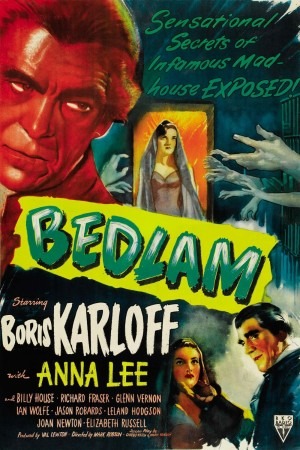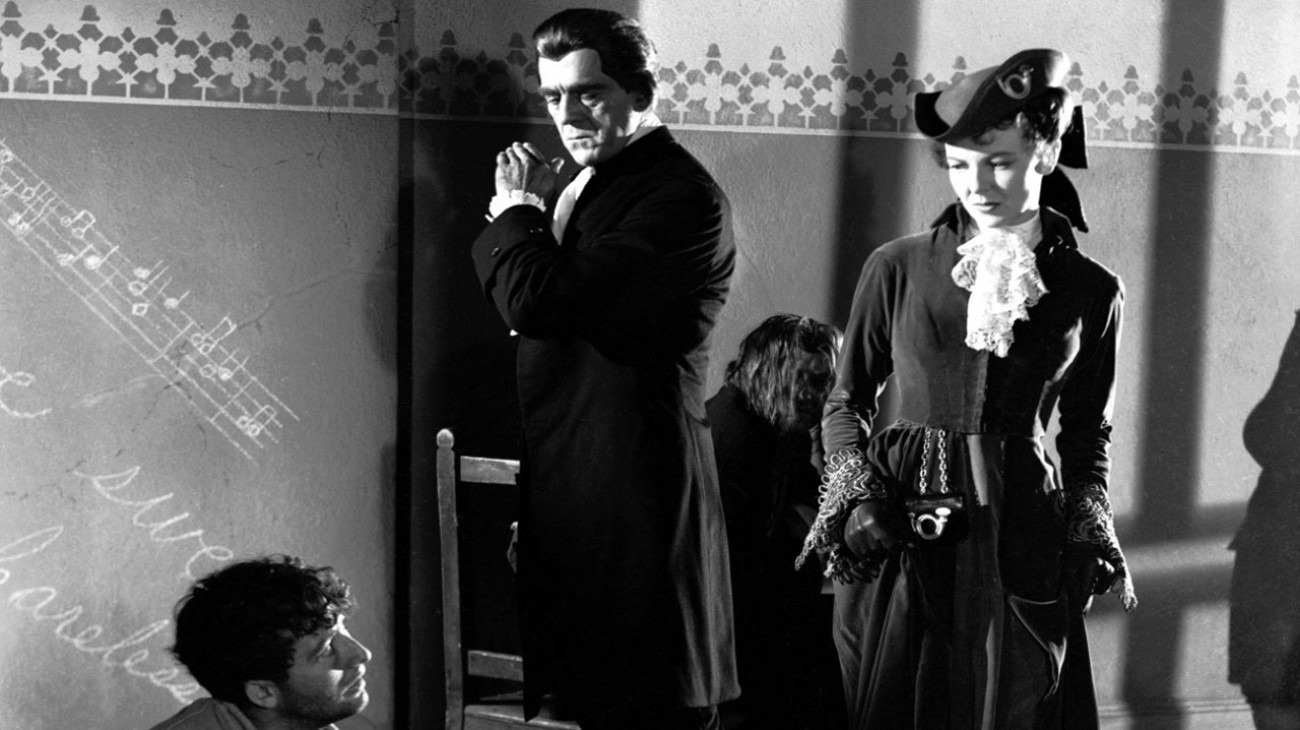
Horror By Lewton: It's a mad, mad, mad, mad world
1945 and the end of the eight years of World War II brought about many changes in manners sociological, cultural, and aesthetic; as will happen when civilization-defining conflicts end. We are going to concern ourselves at present with only one, a small one in the grand scheme: the sudden death of horror in American cinema. Starting in 1931, with the twin releases of Universal's Dracula and Frankenstein, there had been an uninterrupted stretch of various movies about monsters, specters, spooky old houses, inexplicable doings, and the downright uncanny for 14 years; and if horror films were never as prestigious or commercial as musicals, for example, they were still a ready way to make money for the producer who knew how to stretch a dollar. After 1945, the bottom fell out, and horror went into hiding for a terrifically long stretch, emerging only in the shade thrown by sci-fi thrillers in the 1950s, and not returning in a relative pure state until the tail end of that decade.
The theory almost universally advanced for this decline is that a world reeling from the savagery of the larges-scale war ever fought, with its grisly punchline in the discovery of just what exactly the Nazis were up to in those concentration camps, stories of wolf men and mad scientists and things going bump seemed unbelievably quaint and naïve; and who am I to go against convention? Whatever drove this trend, it was real enough, and we are here to take a look at one particular victim of this major shift in tastes, producer Val Lewton. Having turned RKO's B-picture unit into a chiaroscuro cash machine with Cat People in 1942, and having then ridden the public's lingering affection for horror over the next four years as hard as anyone rode it, Lewton went from a virtually instantaneous rise to a virtually instantaneous fall with the early summer release in 1946 of Bedlam, his third feature starring horror icon Boris Karloff; with their previous collaborations, The Body Snatcher and Isle of the Dead, having been the biggest moneymakers in Lewton's career, it must have come as a shock when this lushly-appointed, ambitious period piece - at 79 minutes, the longest the producer had made to date, in any genre, and at $350,000, the most expensive - set a new record for the Lewton Unit: it lost money. With RKO quickly cottoning to the general turn away from horror, Lewton found himself out of a job, and produced only three more movies, for three different studios, none of them horror, before his death at age 47 in 1951. As for Karloff, his career never recovered either; like fellow Universal alum Bela Lugosi, though not to such extremely sad lengths, he began to scrabble for any part that would have him, and while one might enjoy or even adore the likes of The Comedy of Terrors or Die, Monster, Die!, they are plainly not the work of an actor granted his choice of scripts. And while I'll defend Mario Bava's Black Sabbath with my dying breath, no American ever went to work in Italian horror because his career was in good shape.
And as for Bedlam, the movie that thus dumped two horror icons right on their asses; well, the funny thing about it, or ironic anyway, is that this victim of the public's newfound dislike for horror cinema is not, itself a particularly clear-cut example of the form; moreso by the standards of 1946 than today, certainly, but even then it's much more along the lines of the psychological unease in fellow Lewton not-quite-horror picture The Ghost Ship than anything else, and even that only in its back half. As to what it is in its front half, that's something massively unexpected even within the history of a production unit that made its living subverting expectations: would you believe a brittle satire of English social mores during the Age of Johnson? Because if you'd say, "yeah, absolutely", then I hold you to be a damnable liar, madam or sir.
But yes, that's exactly where we end up: a leading title card pointing out that at the time, English intelligentsia liked to consider theirs an "Age of Reason", complete with scare quotes, and then we arrive in 1761, to find a cluster of wits all behaving abominably: Tory politician Lord Mortimer (Billy House), who demands constant amusement from those seeking to curry his favor, among whom the two most important for the plot are Nell Bowen (Anna Lee) and George Sims (Karloff), apothecary general of the St. Mary's of Bethlehem asylum, commonly nicknamed "Bedlam" (a barely-disguised version of the infamous Bethlehem Royal Hospital, presumably changed to avoid tangling with the modern, far less notorious incarnation of that institution). Bitter enemies to the core, Bowen and Sims engage in no end of verbal warfare, he incensed at her influence over Mortimer's tastes, she put off by his unappetizing cruelty and general ugliness, and at the moment the film begins, she's winning: for as the movie begins, a poet beloved by Mortimer, staying in Bedlam for unclear reasons, just happened to fall off the roof, and he just happened to have been a literary rival to Sims, an amateur poet himself, and Mortimer and Bowen have their own ideas about how that situation might have arisen.
In short, there's a solid 40 minutes of politicking as Bowen and Sims both use their various tools to keep Mortimer on their side - she her "look, don't touch" flirtatiousness and biting tongue, he the population of lunatics he brings to fancy parties as amusing sideshow attractions - but it ultimately ends badly, with Sims deciding to take the gloves off, and just Bowen committed to Bedlam already. And thus the movie abruptly and violently becomes the story of her attempts to survive incarceration in a giant, dank room full of madmen and social undesirables, largely by means of trying to improve the lot of all the Bedlamites, aided by a Quaker stonemason (Richard Fraser) who also managed to get on Sims's wrong side early on.
This situation feels like it would lend itself rather well to traditional horror film terrors, particularly with director Mark Robson and cinematographer Nicholas Musuraca making the inside of the hospital look so despicably dark and forbidding, and there are certainly shots and even entire scenes that click on that level; but ultimately, Bedlam refuses to commit fully to being that kind of horror film, lest it fall into the same trap that it sets for Bowen: namely, talking about how it wants to help the inmates, but secretly being terrified of them. For Bedlam is a full-on message picture about how shamefully we treated the mentally ill back in 1761, and how loathsome was a society that would encourage such treatment just so the rich could keep themselves entertained by exploiting the insane, which is kind of an odd message to sell with quite so much urgency in 1946, but there you have it. The screenplay, co-written by Robson and Lewton, wants to teach us a lesson, and if tamping down the horror is what it takes to make that message work, then so be it.
As such, Bedlam is the one Lewton horror picture that, to my eyes anyway, does not work as horror at all (if we discount The Curse of the Cat People as having a filthy, misleading title for a film with no horror elements to speak of), largely because the horror and thriller elements within it are such an evident afterthought, while the attempt to evoke the arch society of 18th Century London is treated with unabashed, loving detail. At any rate, the film is not badly made: Lewton made damn certain that his extra budget would go to good use, and the film's design by Albert S. D'Agostino and Walter E. Keller looks better and fuller than in any previous Lewton film, even the ones where he was stealing sets from The Magnificent Ambersons (themselves by D'Agostino, though so much at RKO was, in those days). And on the level of sheer direction, Robson was as good here as he'd been since The Seventh Victim, and frankly as good as he'd ever be again in a career that got increasingly middlebrow as it went on: the film opens with an astonishingly courageous tracking shock in from an establishing shot of Bedlam all the way up to focus on one man hanging from its gutters; later, there's an almost-equally impressive dolly back that reveals the nightmarish interior of Bedlam when Bowen first steps inside.
Karloff, unsurprisingly, is very good at least, though without as much to do as he had in his previous films with Lewton, he isn't able to reach the same fever pitch of menace as in either of those pictures, settling instead to play Sims as just a nasty, selfish man with a good head for manipulation; only in his final couple of scenes, as the inmates of Bedlam get their inevitable revenge, does he really get to match the best of his career. What's more impressive, perhaps, is that Anna Lee turns in an excellent performance herself, arguably the first time in any of the Karloff vehicles produced at RKO that he was matched with another performance anywhere near his own level: and with Nell Bowen providing a much richer part to play (a haughty, dispassionate woman roused first to pity, then to terror, then to self-righteousness), and with more intimidatingly archaic dialogue to sell, she gets an even better chance to make a strong impression that Karloff himself, and she does so.
It's certainly the case that the film requires an abnormal enthusiasm for B-movie replications of 18th Century conversation styles, and this might be as tiny a niche as any Lewton film ever aimed for; certainly, fans of the psychologically-driven creepiness of his earlier - and, undeniably, better - movies would be hard-pressed to recognise much other than the shadow-soaked visuals from the producer's best work. And even speaking as one who likes the film probably more than it deserves, I can't help but be disappointed that the producer went out on a comparatively low point - the only lesser film in his horror canon is its immediate predecessor, Isle of the Dead. It's a weak end to a great career, but not, in and of itself, a bad movie, even if its greatest value is as a little curiosity - one last time that Val Lewton made a movie that was exactly not what you'd have expected it to be, just out of the desire to keep pushing himself into new, weird directions.
Reviews in this series
Cat People (Tourneur, 1942)
I Walked with a Zombie (Tourneur, 1943)
The Leopard Man (Tourneur, 1943)
The Seventh Victim (Robson, 1943)
The Ghost Ship (Robson, 1943)
The Curse of the Cat People (von Fritsch/Wise, 1944)
The Body Snatcher (Wise, 1945)
Isle of the Dead (Robson, 1945)
Bedlam (Robson, 1946)






